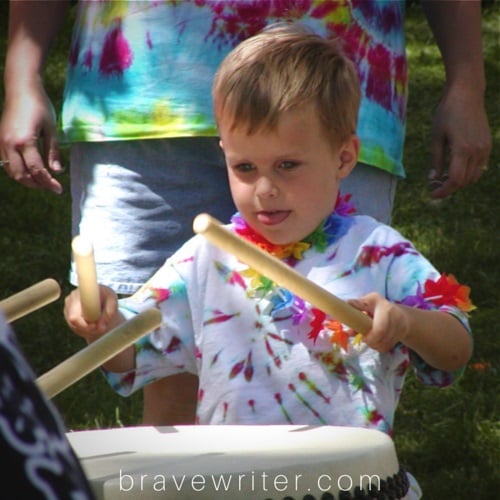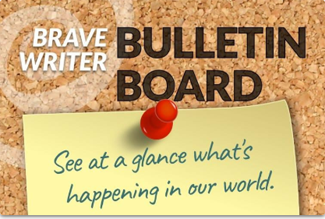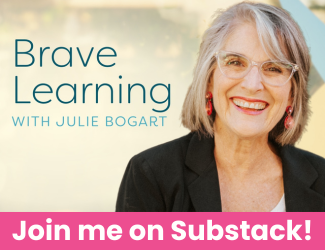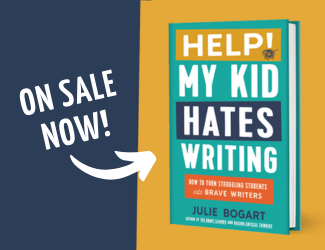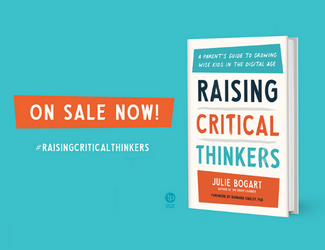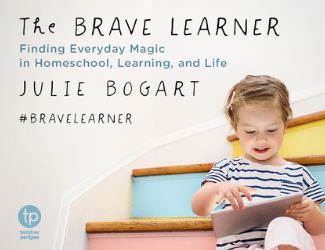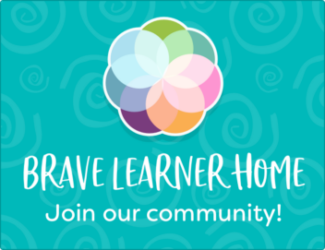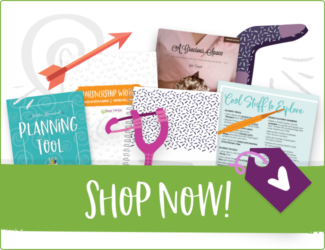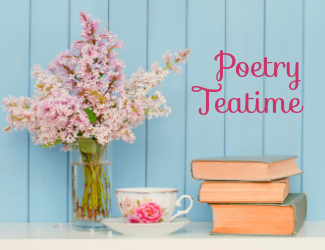Who or what has had a strong influence in your life?
Archive for October, 2009
From the Forums: When it works, it works!
Last year we took the WONDERFUL copywork/dictation class and now we are slowly working our way through The Writer’s Jungle. Today my children did their first keen observation exercises.
Samuel, age 8, dictated the following to me with just a little bit of help:
Lightsaber
———-
It has a light-blue blade with streaks of white on it. It has a red button that you pull down to open it. It has six grips on it. One has a little, tiny, white streak on it. In the back of it, it has a knob with ridges going all around it with a dot the color of bronze in the middle of it. Right above that there is this thing that looks kind of like a little clothespin but you can not close it. And it has some black on the rim of it.
On each side of the lightsaber, it has two little bumps with a circle going around it. Above the red button I told you about there is a little silver circle. Above that is a black strip that curves in a moon shape, going out to the sides. On the sides, there is a hump that goes up, around the back, and back down on the other side. Then in the middle of the handle, there is more than 55 tiny, pointy studs going around the middle. It feels a little sharpish but it has a good grip.
It tastes like stale crackers.
In the middle of the left side of the lightsaber, there is a rectangle that goes a half-inch off the side of the lightsaber. On the top of that, there is a gold line about half-inch wide and two inches long and it has perpendicular and parallell lines carved on it and it has two little black spots on the top. And on the side of that rectangle, there is this little thing coming off of it that looks like a bed and it has a black spot at one tip. At the bottom of it, near the grip, is a black hook so you could hook it on your pants.
When the blade is coming out, it sounds like a fast-moving river. When it is going back in, it sounds like a brief drum roll.
The smell is like perfume. That’s why I don’t smell it that much.
———————————–
Jane, 10 years old, wrote the following all by herself about a large multi-colored fake gemstone. (I corrected all of her spelling a punctuation errors as I typed this in):
This fake diamond is an amazing mix of colors. When I lean my head to one side, the sun relects on the little, triangular, tinted plates, creating a rose-blended lavendar, while some still remain an emerald green. The diamond-shaped, colored plates surrounding the outer edge can appear gold in some forms of lighting or lavendar, and in other cases emerald color. The inner plate can, too, appear a most majestic gold. Once I turn on the light the colors become deeper and darker like a dark, deep sea.
It feels cold to the touch, like icy metal. But it warms slowly as you keep your hand on it. The back is coated with a light metal surface.
It smells like a clear icy morning, so clear and airy almost like nothing. When I rub it on a wood surface, it sounds rocky and raspy like a not-so-clear voice coming over an old-fashioned radio. Sometimes when I touch it with a warm hand, it feels sweaty, the way it does when you grip a penny too hard and too long.
In the front there is a flat, circular, clearish plate, which is surrounded by the diamond plates I told you about. I think it is very complex and interesting to think about.
——————————-
I’m pleased with their results. We’ve read good books & they’ve done narration for many years. For the past year, we’ve done copywork, dictation & freewriting regularly. We just completed the Farmer Boy Arrow that caused us to discuss and notice descriptive details, especially for my daughter. We also recently played the communication game, which really helped my son notice & describe details. I think all those things helped prepare them for this valuable exercise. I LOVE this approach to language arts! It’s so natural, fun & productive, too.
–Betsy R
It’s the Little Things…
A reminder to do the little things that make for pleasantness in your home:
Have you….
- hugged your kids?
surprised someone with a treat?
tickled someone?
made a joke?
pointed out beauty to someone else?
stopped to listen to laughter?
looked out the window and saw, really saw, a bird?
had an unhurried cup of tea?
been thankful for good health?
read something worth reading?
smiled?
jumped up and down to get your heart pumping?
put on lipstick?
read a poem?
looked into your child’s eyes while she was telling you something?
ate tasty food?
gone for a walk?
asked for a hug?
admired a child’s good attitude?
forgave yourself?
wrote a few sentences?
cleared the coffee table and put out something new to read or look at?
lit a candle, put a flower in a vase, arranged the fruit in a bowl?
inhaled deeply, exhaled slowly?
Hope so. Do any one of these and let your day unfold.
It’s the little things….
Friday Freewrite: Three Words
Cherry
Espionage
Dance
Freewrite for your usual amount of time fitting these three words into what you write. Go!
Finding a Rhythm
The Brave Writer Lifestyle may be in danger of becoming a group of words that lose meaning. When I first chose the word “lifestyle” to express the kind of language arts and writing environment that I hope families can create, I did so because I wanted to undercut the negative associations with the word “curriculum.”
“Lifestyle” is a routine or habit of being that relishes good books, writing, poetry, language, talking, movie viewing, and listening. These habits of being will foster better spelling, deeper readings, insight into stories and plots, an appreciation for good writing, an ability to translate one’s thoughts into written expression, a sophisticated vocabulary, interest in languages, (especially one’s own), openness to all kinds of writing genres (including poetry, plays, fiction and non-fiction), and a general love for the language arts.
Because we use the term “lifestyle” so much around here, it might become just the third word in the trio that substitutes for what others might see as a curriculum.
A writing curriculum or a language arts program is geared toward mastering skills. They may, as a by-product, help you to deconstruct difficult grammar, discover a wonderful book or teach helpful writing techniques. Additionally, a program offers structure and a linear step-by-step measurement of movement forward. This is why curricula and programs will never completely fall out of fashion and have their place! But they are not a lifestyle.
Brave Writer offers a different vision. We have certain practices we recommend that have proven beneficial for grammar and spelling, for writing and narrating. But they are simply that: habits or practices. They can be used to advantage or skipped for a time while a child investigates some other aspect of language or writing. You can use programs and curricula to support you in a targeted area of language arts or writing instruction (like an online class, or programs like the Arrow or Boomerang). But these are supports to the lifestyle, not substitutes for it.
A lifestyle implies habit and fluidity, routine and flexibility. You get to decide what is working and what is not.
For those who are “‘tweens” – between curricula and the vision of a lifestyle – let me offer you a single suggestion for how to embrace the lifestyle as you reorient yourselves.
Start with ONE thing.
 Pick one activity or habit or practice or idea that sounds fun to you and do that first. Do it well. Don’t add to it.
Pick one activity or habit or practice or idea that sounds fun to you and do that first. Do it well. Don’t add to it.
So if you want to read poetry with your kids, go to the library and find a good poetry book. Just get a poetry book. Don’t get sixteen other books to read.
Share the book with your kids. Leave it on the coffee table. Read it at bedtime or with tea or during dinner. Let your kids read and hold it. Mark your favorite poems with bookmarks and reread them. Memorize a poem. Write one each morning on the white board. Write a poem in a notecard and keep it in your pocket all day, then reread it in the morning, in the grocery line and before you make dinner.
Enjoy poetry.
Too often we rush through the ideas on our list of good ideas and then wonder why nothing is taking hold. Stop. Read the ONE book and see how much you can get out of it for a week.
Maybe you’ll illustrate poems, or copy them over, or read them at the dentist’s office, or memorize one to share with visiting relatives. Maybe you’ll want to write a poem yourself. Maybe your kids will. Maybe this book will lead you to another book of poems or to one single poet. Let it do its work. Don’t force it.
The point is that if you make poetry just one of the many things you must do this week to achieve the “Brave Writer Lifestyle,” you may not enjoy the poetry. You might find yourself thinking about how after you read the poetry book, you ought to be copying quotes into copy books. And what about freewriting? And will that subscription to the Arrow turn out to be worth it? Suddenly your mind is off of the poem and on “curriculum planning.”
Don’t fall for that trap.
Slow down. Start with one thing. You can build on one good experience. You’ll find that one positive language arts experience enriches the whole. Perhaps the poem you read will naturally lend itself to a discussion of theme (Gerard Manley Hopkins), or grammar (Lewis Carroll), or word choice (Jack Prelutsky), or even a historical moment that gives context to the poet’s writing (Langston Hughes).
When you have exhausted the poetry book, pick the next enticing idea. (Don’t pick the one you think you should pick – I give you permission to follow your enthusiasm.) Enjoy it. Live it.
Follow these steps:
- Prepare for the experience (get the book, buy the ingredients for a recipe for teatime, read ahead in the novel, order the film from Netflix – whatever the activity is).
- Set up the experience for success by picking a date and planning to execute it that day. Clear your day of other burdens. Focus.
- BE HERE NOW – while you are in the experience, don’t let your mind wander to math or orthodontist appointments or bills. Unplug the phone, turn the ringer off your cell, close the laptop. Enjoy what you are doing and do it fully, without guilt.
- Reminisce. When the experience ends, a few days later, talk about it. Remember what was enjoyable. Say it out loud, to your kids, to your friends. Write it up in a blog or email your mother. Be sure to validate the positive experience so that it becomes a memory to treasure and share.
You might notice that these steps work great for teatimes or trips to the art museum. What about something more philosophical like, listening attentively to your children? Start by thinking of all the ways you can be a better listener. Can you take one child out for coffee, another on a walk, swim with one at the Y, see a movie and then chat about it on the way home with yet another?
Do it! It counts. See where it leads.
Can you choose to sit on the couch for a minute today with one child? Might it work to put one child to bed and to lie on that bed for fifteen minutes to cuddle and converse? Do it! Plan it, set it up for success, be fully in the moment and then remember the good that came from it.
You can’t plan time for listening and then fill up your days with lots of busy work. Focus on listening and let that be the frame of reference for everything you do that week.
Allow this year to be the one where you taste-test all the great ideas. Some will stick. Some will bomb. The ones that energize you and your kids will become natural habits because they make you and your kids happy, and you see fruit in their lives.
After many months, you will find that you have a lifestyle all your own.
Images: boy drumming by Bev Sykes and library by Enokson (cc cropped, text added)

